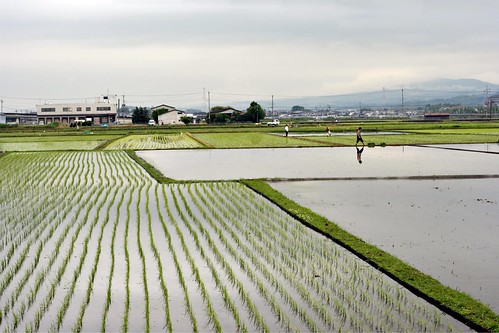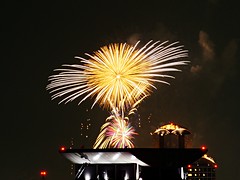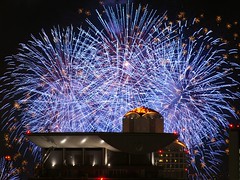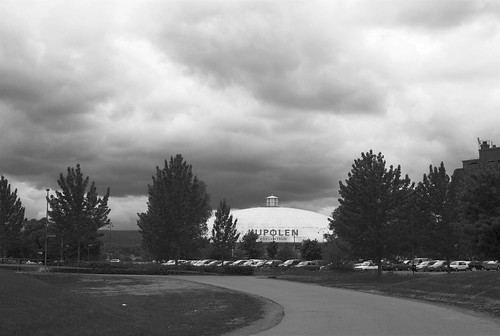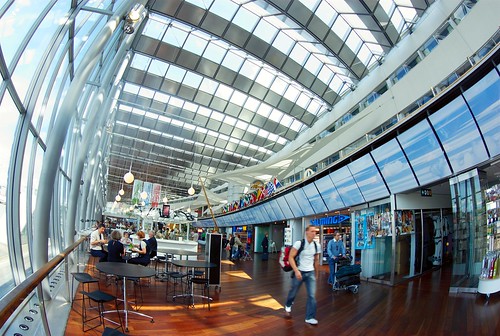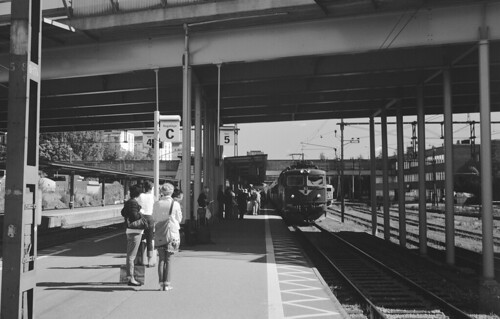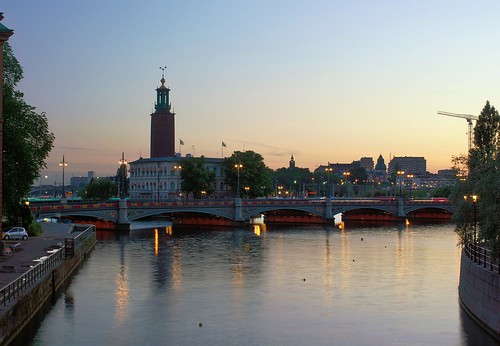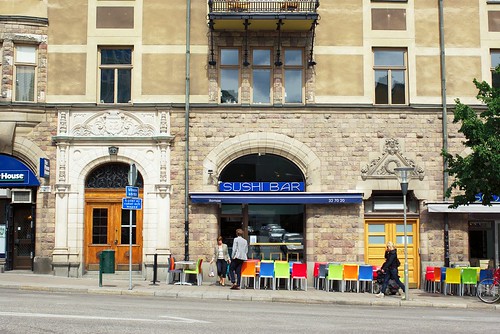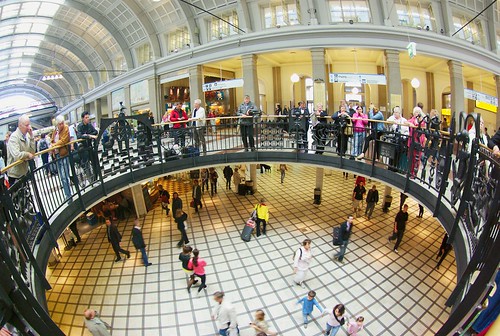Japan has had no luck with their Ministers of Agriculture lately. First, Toshikatsu Matsuoka was investigated for embezzlement of public funds; his political election organisation had submitted receipts for reimbursement of non-existent outlays. He committed suicide just the day before he was to be questioned on corruption charges. Then his replacement Norihiko Akagi resigned after only a few months when investigated for the same kind of embezzlement. Takehiko Endo managed a whole eight (8) days in office as Akagi's replacement before it came to light that a farming association headed by him also had misappropriated funds. Masatoshi Wakabayashi, the replacement, is a sort of eternal understudy in this role; he's been getting this cabinet post several times as a previous minister flamed out. This time it lasted for all of nine days, when the entire Abe cabinet fell.
With the end of the Abe era - and what an era for anyone with any interest in politics as spectator sport! - things looked to slow down even at the Agriculture, Forestry and Fisheries. Wakabayashi stayed on as Agriculture minister under prime minister Fukuda and managed to stay out of trouble; that is in itself a respectable achievement for a minister of Agriculture and probably the reason he keeps popping up there. But in the recent cabinet reshuffle he was replaced, by Seiichi Oota - perhaps Fukuda thought the ministry had grown too quiet and low-profile, what with rising food prices, whaling controversies and a number of homegrown and foreign food scandals making the electorate unhappy. In Oota he apparently got what he wanted. In short order he called the Japanese public "noisy" about the tainted Chinese dumplings (hint: don't insult your voters), and today Okumura-san reports that he seems to have done exactly the same thing as his predecessors, misappropriating government funds for his own political operation.
It can't be coincidental. It is, I think, way past time to conduct a thorough examination of the Agricultural ministry - the buildings, not the people. With four ministers all self-destructing in such a transparent manner there has to be something in the water, or in the food at their cafeteria (well, food safety is an ongoing problem here...), or some neurotoxin in the wall paint perhaps.
Either that, or Wakabayashi has an agricultural Mad Scientist alter ego that has developed a carrot-powered Stupid Ray and is aiming it at the Agriculture ministry corner office whenever he is replaced as minister in order to reclaim "his" ministry. I would not entirely rule it out, however; anyone check where he actually goes between stints as a Minister of agriculture?
Tuesday, August 26, 2008
Monday, August 25, 2008
The Handy Box
In my neverending efforts to complicate my life - also, I wanted to join the $50 film camera project - I have been making use of another old camera. The Handy Box is a box camera, one of the earliest, most common, easiest to use and cheapest camera types ever produced. It is sometimes said that a camera really just is a box with a hole in one end and a film strip in the other; the box camera comes close. Of course, any camera could be said to be a "box camera" but a rough definition is a rigid, non-foldable camera with simple, straightforward design, no automation and very limited settings. If it needs a battery, or if you can change lenses, it is most definitely not a box camera.
This kind of camera first showed up in the 1880's, and has been in continuous production in some form ever since. While the traditional squarish box shape is no longer used, Instamatic-type cameras are really box cameras with a slightly different shape, and today's disposable cameras are really just small box cameras without a way to change the film.
You can find box cameras just about anywhere. They were made in huge numbers over many years so they keep showing up in garage sales, antiques fairs and second-hand stores, often for tiny sums, or even for free. Since they are so simple it's easy to check if it still works. Open it and trip the shutter a few times to see that it works. Look through the lens to see if it is in reasonable condition. Look for any holes or cracks (it should be pretty obvious if there are any). Make sure the film winder isn't stuck.
The Handy Box is somewhat rare, as it is Swedish-made; while Hasselblad is the only well-known Swedish maker today there were quite a few other camera makers over the last century. "Göteborgs Kamerafabrik" in Gothenburg had been producing a box camera called the "Mefag"; when the company folded around the second world war, the design and tooling was bought by "Svensk Kameraindustri" who produced the Handy Box around 1947 and 19481. There's lots more on the Swedish camera history on Per-Anders Westman's informative site, so far only in Swedish, unfortunately.
This is a solid all-metal 6x6 medium-format box camera, with a leather case and carrying handle. And despite being over 60 years old, it's still in quite good condition. There's a small chip or scratch on the lens, some paint scratches in the corners and a bit of surface rust on the inside but that's about it. The shutter mechanism is smooth and reliable and the viewfinder finds views just like it's supposed to.

The camera insert to the left, and the shell to the right. At the top of the insert is an empty film spool; the full spool goes into the opposite side, on the bottom. The red round window is where you see the markings on the film back so you know which frame you're at and how far to wind the film.
It's simple to load the camera. Open the back, pull out the winding knob and pull out the insert. The lens is actually mounted in the insert, not the outer box. Take out the empty roll in the camera - if it's a wooden roll, save it and get a cheap plastic one from your camera store. Put the film roll in the bottom, pull out the film a bit and insert the end tab of the film into the slit in the empty roll (it's easiest to do this before you put the empty roll in place). Wind the roll a couple of turns then put the empty roll into place at the top of the insert. Slide the insert back into the body. Push the winding knob back; you need to wiggle and twist it a bit to make it catch the slot on the film roll. Wind the film until you get to a wide arrow across the film. Close the back, then wind the film until you get to the first frame.
Once you've shot the film, unloading is even easier. It's best to be in the shadow or indoors. Keep on winding until you see the film end pass in the red window. Wind another couple of turns, open the camera as above and take out the roll. A medium-format roll has a strip of gluey paper at the end that you wet just like a stamp, then wrap around the roll (often in the opposite direction). The roll is actually well-protected from light despite appearances so you don't need to keep it in the dark. It is a good idea to have it developed fairly soon, though.
Operation
The Handy Box aims for simplicity, just like a modern digital point and shoot camera. Unlike the point and shoot, however, it achieves it superbly. A modern camera tries - and fails - to be simple by automating all settings. The Handy Box achieves Zen-like simplicity by having no settings to change.
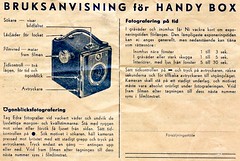
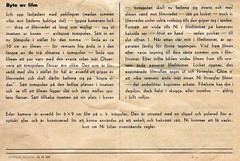
The Handy Box manual. All two pages of it. When the Handy Box aims for simplicity it's not kidding around. How many pages does your typical digital camera manual have? Left of page one describes "instant" photography, and the right side describes "time". The table reads: "Indoors near windows, 1-3 seconds; in gray weather or in shadow, 1-5 seconds; Indoors with window light, 5-30 seconds". Page two describes how to load and unload film.
A big thank you to Per-Anders Westman who kindly scanned his manual for me and sent me the images. It's people like him that make this hobby so rewarding.
A modern camera will try to autofocus for you, but it will take time and it will sometimes focus on the wrong thing or fail to focus at all. Older cameras like the Yashica TLR or Voigtländer Bessa that I've written about need to be focused manually. The Handy Box has a far simpler, more reliable solution: you don't focus the camera at all. The lens is permanently set to a medium distance. It is the ultimate autofocus. If the picture got blurry it's not the camera's fault, you were just not standing in the right place. Selecting the aperture is solved in the same, radically simple way: It is fixed - I measured it to f/16 - and unchangeable. You no longer need to worry about depth of focus issues.
With shutter speed and exposure, too, the Handy Box lives up to its name. Measuring the exposure and setting the right shutter speed is a major worry in modern photography, with whole books devoted to the subject. The Handy Box cuts through this web of complexity: we need no exposure metering since we can't set the shutter speed. The shutter has only two settings: "time" (what we call "bulb" today) and "instant". With the "time" setting, you push the shutter lever one way to open the shutter, and the other way to close it again. At the "instant" setting the shutter will open briefly when you pull the lever, whether up or down. I measured the shutter speed to 1/50 going one way and 1/60 going the other; similar enough to be the same in practice.

The Handy Box viewfinder. It's fairly dim - only useful in daylight, really - and you need to be very precisely positioned to see through it. It's often easier to simply guess your composition.
Fixed focus, fixed aperture, fixed shutter speed - truly, worries about camera settings are a thing of the past with the oh so very handy Handy Box!
What? No settings?
When I first loaded the film and picked up the camera I felt utterly lost. There was no way for me to adjust anything. Our modern cameras give us very precise control; we can adjust every possible setting, and we get instant feedback on everything we do. But while this control is wonderful it is also deceptive; once we can control our settings precisely we soon start to believe that we must do so. We start thinking that a picture that isn't perfectly controlled - perfect focus, perfect exposure, perfect color - is not a good image.
We amateurs and enthusiasts tend to forget that the picture is not the image (professional photographers know this, which is why they spend their time arguing royalty rates and licensing, not pixel-level sharpness). The World Press Photo exhibition passed by Osaka two weeks ago. It honours the best press photography of the year. When you look closely, you realize that a lot of those images are not well controlled; focus, exposure and color may all be off. But a soft or dark image may convey its subject as strongly as a technically perfect one. Many things go into making a good image and technical quality is only one of them.
The most important advice for using an old camera like this is to work with the camera, not fight against it. Use its strengths and embrace its weaknesses. When you have no control over focus or exposure, you don't want to try shooting a wedding album. If your camera is slow to set up and use, don't use it for sports photography. If it's unreliable and erratic, it's no good for scientific imaging ("the camera didn't fire. We have to redo the experiment. All twelve hours of it.").
The Handy Box is not a sharp camera. It has a good amount of distortion, both barrel distortion and vignetting. The images are pretty low contrast and really benefit from a healthy contrast bump in postprocessing. But it is small and light, it's fast (no need to set anything, remember), it's quiet and it is very discreet - people often don't realize it's a camera at all. In other words, it's a really good street camera. Street photography is often in daylight, and the low-fi quality of the images will often complement and enhance the urban motives.
I have another couple of tips for users of older cameras. First, establish a routine. Whenever you have taken a shot, always set the camera back to its standard settings. In my case (as I learned the hard way - see the second picture below) I always wind the film to the next frame and set the shutter to "instant" as soon as I had taken a shot. If you don't make this a habit you will inevitably make a mistake, with interesting consequences. Interesting is good from time to time, of course (I really like that second picture myself), but it's still better to avoid them when you can.
Second, keep a notebook. Your digital camera records all the technical details of your images, but with an older film camera the responsibility is your own. Just make note of the settings you used for each frame so you can go back and compare with the results. And when you're taking notes anyhow it's a good idea to note what you're trying to shoot, and what you're trying to do with the image. It's not easy to remember what you were thinking perhaps weeks after taking it; just a few words jotted down can really help. That helps you improve your composition, not only the technical aspects.
Examples
I shot and developed a roll of Ilford HP5 with this camera last week. The camera is set for sunlit days with the ISO 100 speed films of the time so I figured an ISO 400 film like HP5 should enable me to get decent shots in shadow or when overcast. Sunny days would be too bright so I'd want to avoid that.
The camera really is as easy to use as I say above. When outside, use the "instant" shutter. When inside and it's bright, use something like 1 second (just guesstimate it). In dim light, go to about 3 seconds. If you don't get it exactly, don't worry - black and white film is pretty forgiving, so you'll have a recognizable image even if you're way off on your shutter speed.
Digital photo technology helps us here: since we can easily scan the images and post-process on our computers, exposure problems - and dust, and scratches, and vignetting, and a host of other issues - are much easier to fix today than they were when people printed directly from the negatives. In many ways, these old, manual medium-format cameras are far easier to use than ever before, with the support we can get from digital technology. All the images below have been postprocessed: I removed some dust - not all, just the most obvious specks - adjusted brightness and added some contrast. These are standard tools at our disposal today, we use them for all our other images, and it would be strange not to take advantage of them here as well.
The image quality I get from the Handy Box is pretty even and dependable. Even the images with the most technical issues don't actually look much worse than the technically best ones. When you take a picture with this camera you know what you're going to get. This dependability is part of why it's so amazingly easy to handle: I never measured the light level for any of the images above, and I didn't time the shutter; still, the images turned out good. And with no worries about any technical aspects I had a blast taking them.
I've collected all images related to this camera in its own Flickr set.
Below are the twelve frames from this roll of film, in order.

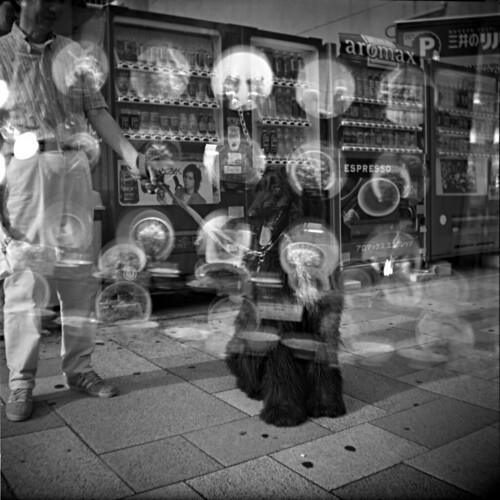
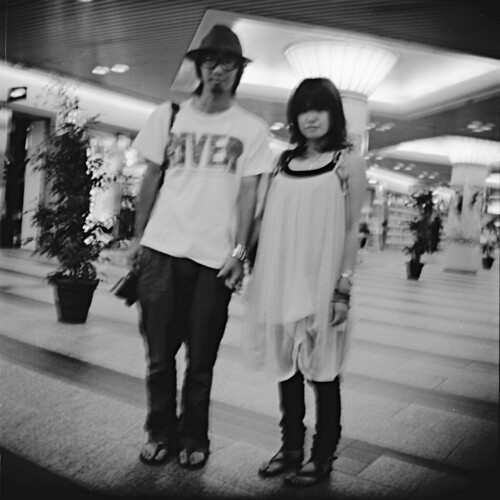
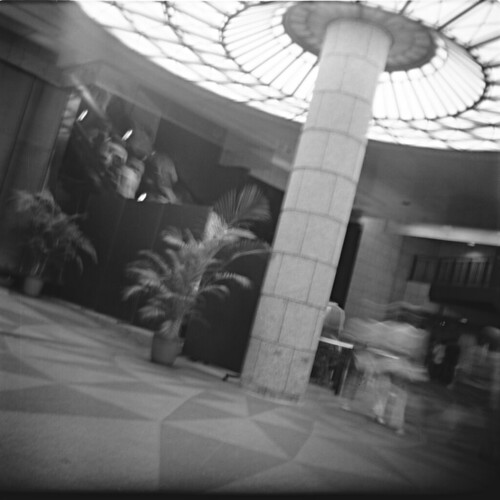
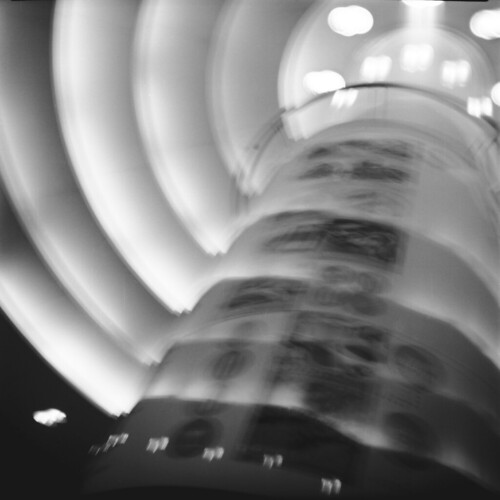
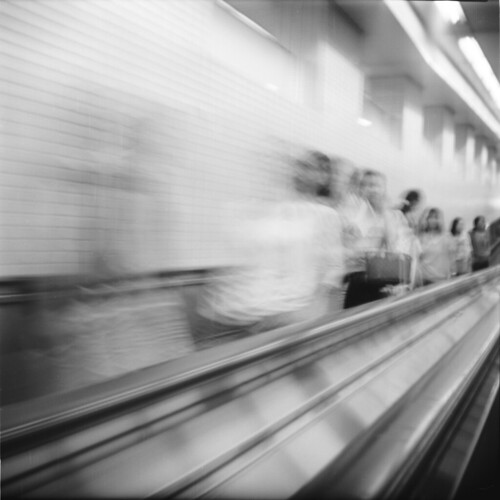
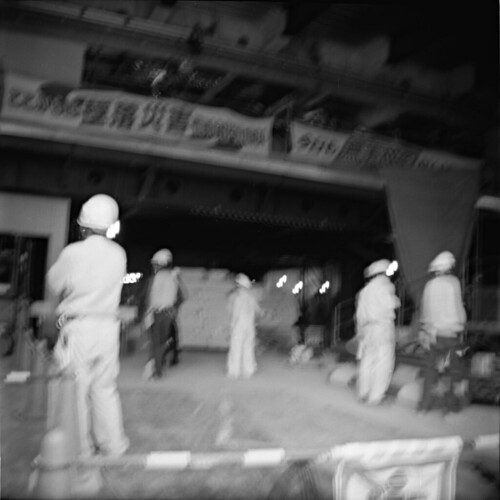
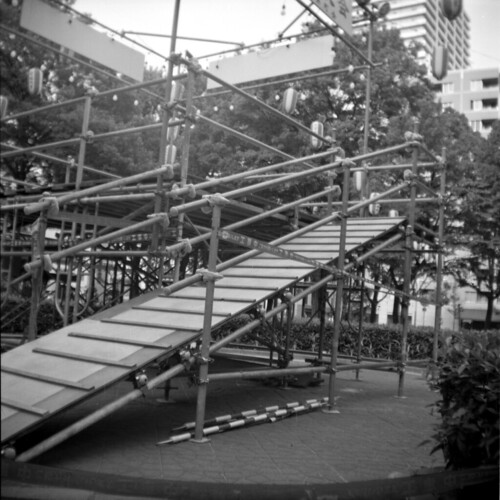
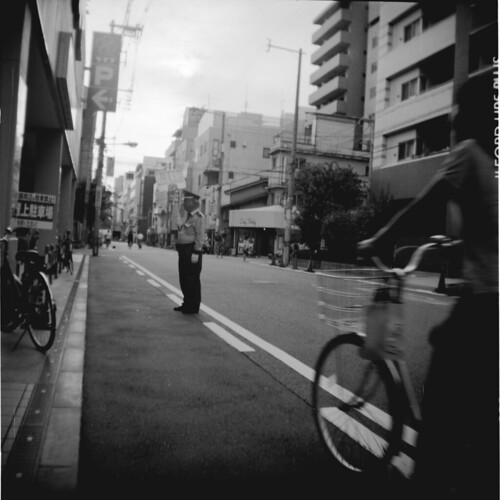
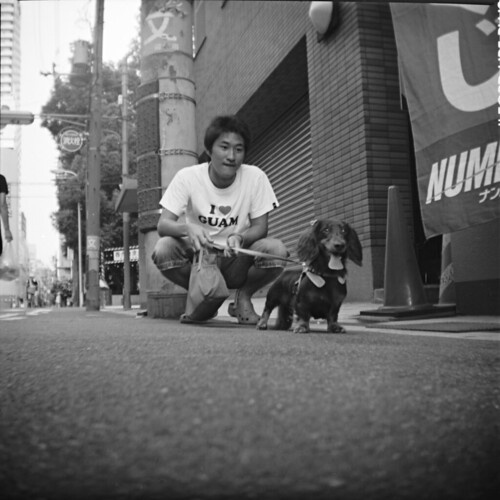
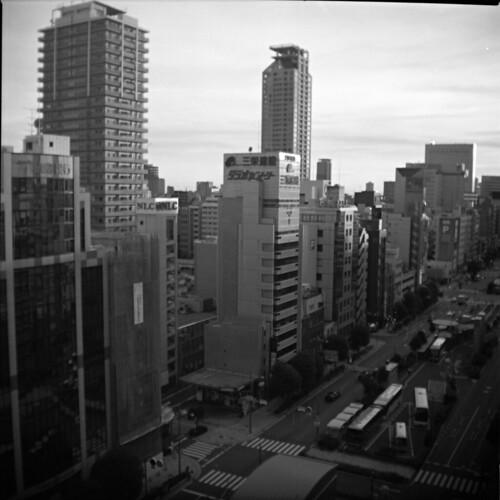

EDIT August 2011: Changed links to Per-Anders Westmans current homepage.
---
#1 The name "Göteborgs Kamerafabrik", by the way, means "Gothenburgs Camera Factory" and "Svensk Kameraindustri" means "Swedish Camera Industry", harking back to an era when company names still had a connection to what they were actually doing; do you have any clue what kind of business, say Accentor or Ingenico are in, without clicking through to check?
This kind of camera first showed up in the 1880's, and has been in continuous production in some form ever since. While the traditional squarish box shape is no longer used, Instamatic-type cameras are really box cameras with a slightly different shape, and today's disposable cameras are really just small box cameras without a way to change the film.
You can find box cameras just about anywhere. They were made in huge numbers over many years so they keep showing up in garage sales, antiques fairs and second-hand stores, often for tiny sums, or even for free. Since they are so simple it's easy to check if it still works. Open it and trip the shutter a few times to see that it works. Look through the lens to see if it is in reasonable condition. Look for any holes or cracks (it should be pretty obvious if there are any). Make sure the film winder isn't stuck.
The Handy Box is somewhat rare, as it is Swedish-made; while Hasselblad is the only well-known Swedish maker today there were quite a few other camera makers over the last century. "Göteborgs Kamerafabrik" in Gothenburg had been producing a box camera called the "Mefag"; when the company folded around the second world war, the design and tooling was bought by "Svensk Kameraindustri" who produced the Handy Box around 1947 and 19481. There's lots more on the Swedish camera history on Per-Anders Westman's informative site, so far only in Swedish, unfortunately.
This is a solid all-metal 6x6 medium-format box camera, with a leather case and carrying handle. And despite being over 60 years old, it's still in quite good condition. There's a small chip or scratch on the lens, some paint scratches in the corners and a bit of surface rust on the inside but that's about it. The shutter mechanism is smooth and reliable and the viewfinder finds views just like it's supposed to.

The camera insert to the left, and the shell to the right. At the top of the insert is an empty film spool; the full spool goes into the opposite side, on the bottom. The red round window is where you see the markings on the film back so you know which frame you're at and how far to wind the film.
It's simple to load the camera. Open the back, pull out the winding knob and pull out the insert. The lens is actually mounted in the insert, not the outer box. Take out the empty roll in the camera - if it's a wooden roll, save it and get a cheap plastic one from your camera store. Put the film roll in the bottom, pull out the film a bit and insert the end tab of the film into the slit in the empty roll (it's easiest to do this before you put the empty roll in place). Wind the roll a couple of turns then put the empty roll into place at the top of the insert. Slide the insert back into the body. Push the winding knob back; you need to wiggle and twist it a bit to make it catch the slot on the film roll. Wind the film until you get to a wide arrow across the film. Close the back, then wind the film until you get to the first frame.
Once you've shot the film, unloading is even easier. It's best to be in the shadow or indoors. Keep on winding until you see the film end pass in the red window. Wind another couple of turns, open the camera as above and take out the roll. A medium-format roll has a strip of gluey paper at the end that you wet just like a stamp, then wrap around the roll (often in the opposite direction). The roll is actually well-protected from light despite appearances so you don't need to keep it in the dark. It is a good idea to have it developed fairly soon, though.
Operation
The Handy Box aims for simplicity, just like a modern digital point and shoot camera. Unlike the point and shoot, however, it achieves it superbly. A modern camera tries - and fails - to be simple by automating all settings. The Handy Box achieves Zen-like simplicity by having no settings to change.


The Handy Box manual. All two pages of it. When the Handy Box aims for simplicity it's not kidding around. How many pages does your typical digital camera manual have? Left of page one describes "instant" photography, and the right side describes "time". The table reads: "Indoors near windows, 1-3 seconds; in gray weather or in shadow, 1-5 seconds; Indoors with window light, 5-30 seconds". Page two describes how to load and unload film.
A big thank you to Per-Anders Westman who kindly scanned his manual for me and sent me the images. It's people like him that make this hobby so rewarding.
A modern camera will try to autofocus for you, but it will take time and it will sometimes focus on the wrong thing or fail to focus at all. Older cameras like the Yashica TLR or Voigtländer Bessa that I've written about need to be focused manually. The Handy Box has a far simpler, more reliable solution: you don't focus the camera at all. The lens is permanently set to a medium distance. It is the ultimate autofocus. If the picture got blurry it's not the camera's fault, you were just not standing in the right place. Selecting the aperture is solved in the same, radically simple way: It is fixed - I measured it to f/16 - and unchangeable. You no longer need to worry about depth of focus issues.
With shutter speed and exposure, too, the Handy Box lives up to its name. Measuring the exposure and setting the right shutter speed is a major worry in modern photography, with whole books devoted to the subject. The Handy Box cuts through this web of complexity: we need no exposure metering since we can't set the shutter speed. The shutter has only two settings: "time" (what we call "bulb" today) and "instant". With the "time" setting, you push the shutter lever one way to open the shutter, and the other way to close it again. At the "instant" setting the shutter will open briefly when you pull the lever, whether up or down. I measured the shutter speed to 1/50 going one way and 1/60 going the other; similar enough to be the same in practice.

The Handy Box viewfinder. It's fairly dim - only useful in daylight, really - and you need to be very precisely positioned to see through it. It's often easier to simply guess your composition.
Fixed focus, fixed aperture, fixed shutter speed - truly, worries about camera settings are a thing of the past with the oh so very handy Handy Box!
What? No settings?
When I first loaded the film and picked up the camera I felt utterly lost. There was no way for me to adjust anything. Our modern cameras give us very precise control; we can adjust every possible setting, and we get instant feedback on everything we do. But while this control is wonderful it is also deceptive; once we can control our settings precisely we soon start to believe that we must do so. We start thinking that a picture that isn't perfectly controlled - perfect focus, perfect exposure, perfect color - is not a good image.
We amateurs and enthusiasts tend to forget that the picture is not the image (professional photographers know this, which is why they spend their time arguing royalty rates and licensing, not pixel-level sharpness). The World Press Photo exhibition passed by Osaka two weeks ago. It honours the best press photography of the year. When you look closely, you realize that a lot of those images are not well controlled; focus, exposure and color may all be off. But a soft or dark image may convey its subject as strongly as a technically perfect one. Many things go into making a good image and technical quality is only one of them.
The most important advice for using an old camera like this is to work with the camera, not fight against it. Use its strengths and embrace its weaknesses. When you have no control over focus or exposure, you don't want to try shooting a wedding album. If your camera is slow to set up and use, don't use it for sports photography. If it's unreliable and erratic, it's no good for scientific imaging ("the camera didn't fire. We have to redo the experiment. All twelve hours of it.").
The Handy Box is not a sharp camera. It has a good amount of distortion, both barrel distortion and vignetting. The images are pretty low contrast and really benefit from a healthy contrast bump in postprocessing. But it is small and light, it's fast (no need to set anything, remember), it's quiet and it is very discreet - people often don't realize it's a camera at all. In other words, it's a really good street camera. Street photography is often in daylight, and the low-fi quality of the images will often complement and enhance the urban motives.
I have another couple of tips for users of older cameras. First, establish a routine. Whenever you have taken a shot, always set the camera back to its standard settings. In my case (as I learned the hard way - see the second picture below) I always wind the film to the next frame and set the shutter to "instant" as soon as I had taken a shot. If you don't make this a habit you will inevitably make a mistake, with interesting consequences. Interesting is good from time to time, of course (I really like that second picture myself), but it's still better to avoid them when you can.
Second, keep a notebook. Your digital camera records all the technical details of your images, but with an older film camera the responsibility is your own. Just make note of the settings you used for each frame so you can go back and compare with the results. And when you're taking notes anyhow it's a good idea to note what you're trying to shoot, and what you're trying to do with the image. It's not easy to remember what you were thinking perhaps weeks after taking it; just a few words jotted down can really help. That helps you improve your composition, not only the technical aspects.
Examples
I shot and developed a roll of Ilford HP5 with this camera last week. The camera is set for sunlit days with the ISO 100 speed films of the time so I figured an ISO 400 film like HP5 should enable me to get decent shots in shadow or when overcast. Sunny days would be too bright so I'd want to avoid that.
The camera really is as easy to use as I say above. When outside, use the "instant" shutter. When inside and it's bright, use something like 1 second (just guesstimate it). In dim light, go to about 3 seconds. If you don't get it exactly, don't worry - black and white film is pretty forgiving, so you'll have a recognizable image even if you're way off on your shutter speed.
Digital photo technology helps us here: since we can easily scan the images and post-process on our computers, exposure problems - and dust, and scratches, and vignetting, and a host of other issues - are much easier to fix today than they were when people printed directly from the negatives. In many ways, these old, manual medium-format cameras are far easier to use than ever before, with the support we can get from digital technology. All the images below have been postprocessed: I removed some dust - not all, just the most obvious specks - adjusted brightness and added some contrast. These are standard tools at our disposal today, we use them for all our other images, and it would be strange not to take advantage of them here as well.
The image quality I get from the Handy Box is pretty even and dependable. Even the images with the most technical issues don't actually look much worse than the technically best ones. When you take a picture with this camera you know what you're going to get. This dependability is part of why it's so amazingly easy to handle: I never measured the light level for any of the images above, and I didn't time the shutter; still, the images turned out good. And with no worries about any technical aspects I had a blast taking them.
I've collected all images related to this camera in its own Flickr set.
Below are the twelve frames from this roll of film, in order.

"Ok, so I'll wind the film to frame 1. And I'm winding and winding, and here's an arrow in the small red window, and another arrow, and some other symbols, and a small horizontal line, and I'm winding and winding, and here's number '2'. '2'?! Agh, was that a '1' before, not a horizontal line? Oh cr*p."
I scanned this without the film holder so I'd get the film markings on the side. Chalk it up as a learning experience.
I scanned this without the film holder so I'd get the film markings on the side. Chalk it up as a learning experience.

"Ahh, look at that dog! Cute, friendly and thin enough to be almost two-dimensional. The owner looks affable enough. 'Excuse me, could I take a picture?'" The dog owner sees an obviously foreign person brandishing an ancient camera and improbably decides this is a good thing. "'Great! Hold it riiight there. Thank you very much.'"
"It's really hot up on street level; the underground arcade is nice and cool right now. Gotta take a picture of that Ramen restaurant display too. That'll give me an excuse to try longer exposures. Hmm, viewfinder is really hard to see here. Ah, got it. There. Now, wind the film... wind.. the.. film...... Aggh, I forgot to wind it after the dog picture! Poor doggie, and shame about the Ramen."
Easy mistake to avoid, this - make sure you establish a routine as I wrote above. That said, this picture is rather more interesting than either the dog or Ramen display would have been on their own. Almost like a frame from some old Hammer Film horror feature; all it needs is a Vincent Price voice-over.
Composite shot; one taken with "instant" shutter, one at about 1 second.
"It's really hot up on street level; the underground arcade is nice and cool right now. Gotta take a picture of that Ramen restaurant display too. That'll give me an excuse to try longer exposures. Hmm, viewfinder is really hard to see here. Ah, got it. There. Now, wind the film... wind.. the.. film...... Aggh, I forgot to wind it after the dog picture! Poor doggie, and shame about the Ramen."
Easy mistake to avoid, this - make sure you establish a routine as I wrote above. That said, this picture is rather more interesting than either the dog or Ramen display would have been on their own. Almost like a frame from some old Hammer Film horror feature; all it needs is a Vincent Price voice-over.
Composite shot; one taken with "instant" shutter, one at about 1 second.

"Oh look, a hip couple, and with camera and all. Low light portrait time! 'Excuse me, could I take your picture?' 'Yes, both of you; you look cool together. There, just stand there so I get the pillar in the back. It'll be a second or so - stand very, very still.' ... 'Got it, thanks!'"
1 second shutter, underexposed. 2-3 seconds would have been better. Of course, that would have gotten me even more motion blur.
1 second shutter, underexposed. 2-3 seconds would have been better. Of course, that would have gotten me even more motion blur.

"The high ceiling and those pillars here look cool. Could I get the pillar with that escalator? Worth a try. Get motion blur on the people riding it too."
1 second. The whole image is too blurry for the motion blur idea to work.
1 second. The whole image is too blurry for the motion blur idea to work.

"What if I try to get just the pillar, from below, make it abstract? Try to hold it steady somehow; lean the corner of the camera on the floor I think. Aaand guesstimate the time - umm, the light is pretty bright so a bit less than the other shots should be OK."
About 0.5-0.8 seconds or so. My favourite image.
About 0.5-0.8 seconds or so. My favourite image.

"I don't get the point of this horizontal escalator. I mean, the whole arcade is about a kilometer, and this power walkway runs for all of fifty meters. Sure is fun though. Hey, what if I put the camera on the railing and shoot the people gliding by? Worth a shot."
Around 0.5 seconds.
Around 0.5 seconds.

"Construction work. Never fails. Big machinery, exposed frameworks, people in helmets. Pretty dark in there though. Take some extra time perhaps."
2-3 seconds; that overexposed the brightest areas however. And I think the blur is enough to be distracting here.
2-3 seconds; that overexposed the brightest areas however. And I think the blur is enough to be distracting here.

"There's an Obon festival in this park tonight I guess, that's why they've put up the scaffolding and lanterns. Let's see how the camera likes backlight."
"instant" shutter. Backlight is OK; fair bit of veiling glare but nothing distracting.
"instant" shutter. Backlight is OK; fair bit of veiling glare but nothing distracting.

"Nice, deep light - the late afternoon sun is kind of shading the street. If I could just get the guard to look this way... Oh, bicycle coming, got to take it right now."
"instant" shutter. Shadow in late afternoon makes it a bit underexposed.
"instant" shutter. Shadow in late afternoon makes it a bit underexposed.

"Another dog! And crouching owner. 'Crouching Owner, Hidden Dachshund' could be a good movie title. Got to get low here. Rule of thumb: Low dog, low picture."
"instant" shutter. Close areas, like the street at the bottom, are very unfocused; the focal plane seems to be at around 4-5 meters.
"instant" shutter. Close areas, like the street at the bottom, are very unfocused; the focal plane seems to be at around 4-5 meters.

"Evening, and we have a good sunset down Nagahori street. I must have half a dozen images of this already, so I want one for comparison."
"instant" shutter. You can see here that the lens has rather a lot of barrel distortion, with buildings at the edge curving inwards.
"instant" shutter. You can see here that the lens has rather a lot of barrel distortion, with buildings at the edge curving inwards.

"That's some simple, clean geometric light and shadow going on there in the morning light. No way to use the viewfinder so I'll just shoot blind."
"instant" shutter.
"instant" shutter.
EDIT August 2011: Changed links to Per-Anders Westmans current homepage.
---
#1 The name "Göteborgs Kamerafabrik", by the way, means "Gothenburgs Camera Factory" and "Svensk Kameraindustri" means "Swedish Camera Industry", harking back to an era when company names still had a connection to what they were actually doing; do you have any clue what kind of business, say Accentor or Ingenico are in, without clicking through to check?
Friday, August 22, 2008
An Experiment in Coffee Storage
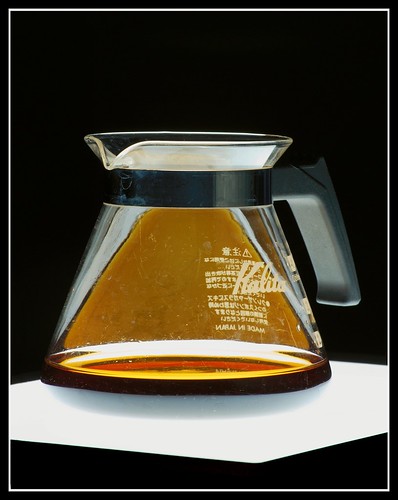 Coffee is perhaps the most popular drug on Earth. There is broad agreement on the different methods to brew coffee, but there is little agreement on how to properly store roasted coffee beans. While everybody agrees that coffee should be ground and used within two weeks or so, this is not always possible. We conducted an informal test and came to the conclusion that chilled, but not frozen, storage offers the best tasting coffee.
Coffee is perhaps the most popular drug on Earth. There is broad agreement on the different methods to brew coffee, but there is little agreement on how to properly store roasted coffee beans. While everybody agrees that coffee should be ground and used within two weeks or so, this is not always possible. We conducted an informal test and came to the conclusion that chilled, but not frozen, storage offers the best tasting coffee.Introduction
We drink coffee; so do many people. You get good coffee by buying whole beans and only grind it as you use it. Normally you should use coffee beans within two weeks of roasting. For the disorganized caffeine addict - such as myself - this is not practical as you constantly risk running out of coffee. And having me got without my morning coffee may be entertaining for onlookers, but rather unpleasant - not to mention dangerous - for myself. So it is prudent to buy and store coffee in larger batches.
But how to store it? It turns out that there is no consensus on this. Some argue for storage in the freezer; that would preserve ethereal oils in the bean that otherwise evaporate. Other argue for room temperature as it keeps the beans dry and away from other foods that can impart flavour. Both groups generally dismiss refrigeration, arguing that it is neither as dry or free of smell as room temperature, nor as effective as the freezer.
As this is a question of vital importance to humanity - or the subset that depends on coffee to wake up in the morning - we resolved to find out, so in June we set up a small experiment. Since this is a real experiment of sorts I thought it could be a nice illustration on how to go about an experiment like this and how to present it. Science is a method or a way of thinking about things, after all, and it doesn't have to be about complex or esoteric things. As a further illustration I write this post in the approximate format - if not the language - of an academic paper1.
In early June we put fresh coffee beans into three sealed plastic bags. One bag went into the freezer, one into the refrigerator, and one into a cupboard. During the Obon holiday last week we took the now two month old coffee beans, and - making sure we did this double-blind2 - brewed three cups. We tasted all three batches at the same time and ranked them in order of preference. We only identified the coffee after we had ranked the batches.
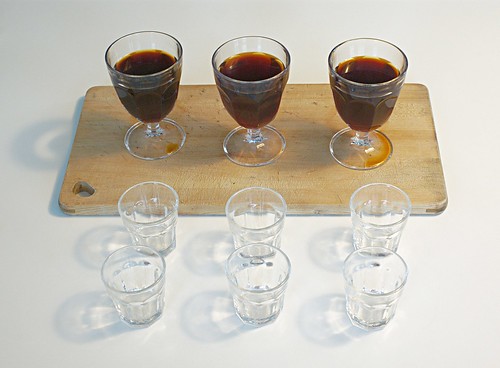
The testing setup. We brewed coffee straight into the three glasses at the top, and while still hot, poured into the small glasses for testing.
We were in complete agreement on the rank order from the beginning; the difference between the batches was surprisingly large. Finishing dead last was the room temperature coffee. It felt thin and sour compared to the other two; there really was no contest. The refrigerator and freezer coffees were closer to each other in flavour and smell, but we both agreed that the refrigerated coffee did taste better and more balanced than the freezer coffee.
The result, in short, was:
1. Refrigerator
2. Freezer
3. Room temperature
Method
In early June we took three small freezer bags such as you can find (not at all coincidentally) by the register in Life supermarkets, and filled with two spoonfuls each of whole roasted Hanshin Special Blend beans - our normal coffee. The amount is approximately equal to that needed for half a pot of coffee. The bags were unused and had been checked for holes. All three bags where compressed to remove as much air as possible, then tied up tightly. One bag was put in the kitchen cupboard we normally store coffee and tea; one was placed in the top shelf of the refrigerator door together with bottles of salad dressing and the like; and one was placed in the freezer.
We waited two months. While this is an unusually long time - we normally use a bag within three to four weeks or so - we wanted to give the coffee sufficient time to develop any differences due to storage type. Also, the Obon holiday was the first opportunity we had to conduct the experiment at our leisure.
For the testing we recruited two experimental subjects. The subjects were two healthy adult humans, one male, one female, that fully understood the nature and purpose of the experiment, and agreed to all conditions. Which is not surprising since the subjects are me and Ritsuko ourselves.
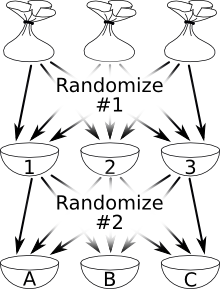 The experiment was rendered double blind by randomizing the labeling, twice, as you can see in the illustration to the left. Without Ritsuko in the kitchen I took out the bags and waited until they all were at room temperature. I opened them and poured the beans into bowls labeled 1, 2 and 3, chosen randomly ("Randomize #1" to the left). Then I left and Ritsuko entered. She took the three bowls, and randomly (we used lots) poured them into mugs labeled A, B and C ("Randomize #2"). As a result, she did not know which bag of coffee was 1, 2 or 3. I knew, but did not know which of the bowls had become A, B or C. Neither of us knew which batch of coffee was in which mug, in other words.
The experiment was rendered double blind by randomizing the labeling, twice, as you can see in the illustration to the left. Without Ritsuko in the kitchen I took out the bags and waited until they all were at room temperature. I opened them and poured the beans into bowls labeled 1, 2 and 3, chosen randomly ("Randomize #1" to the left). Then I left and Ritsuko entered. She took the three bowls, and randomly (we used lots) poured them into mugs labeled A, B and C ("Randomize #2"). As a result, she did not know which bag of coffee was 1, 2 or 3. I knew, but did not know which of the bowls had become A, B or C. Neither of us knew which batch of coffee was in which mug, in other words.We ground each batch using a common mill (not knife) type grinder, with the grinder thoroughly cleaned of coffee grinds before and between each batch (what fun that was). We don't have three coffee pots and filter holders at home unfortunately, instead we took three ordinary glasses (as seen in the picture) and loosely fitted a paper filter with a batch of beans in each of them. We poured the water in two steps, first a little just to soak the grinds, then enough hot water to fill each glass with coffee. The resulting coffee was a bit thicker and stronger than normal for us.
To test the coffee we used small snaps-glasses, one glass per batch per person (the small glasses in the image). Tasting was free-form, and we were slow enough that we got to taste each batch both hot and cool. We ranked each batch individually, then compared notes.
Results
The results were completely unambiguous: the room-temperature stored coffee was ranked last by both me and Ritsuko. We were in complete agreement that it was significantly worse in every respect to the other two; thin and with a somewhat unpleasant sour aftertaste. When compared to the other two I was almost hesitant to finish the glass. Almost - I mean, it's still coffee after all.
The two chilled batches were significantly better, and closer in taste and smell to each other, than the room temperature batch. But here too, there was a clear difference and we were both in agreement. The frozen coffee was more bitter and thicker, while the refrigerated coffee was well balanced with somewhat less bitterness and richer flavours. Nothing changed as the coffee cooled: the refrigerated beans tasted somewhat better than the frozen ones, and a lot better than the room-temperature beans.
Discussion
Our aim has been to find out how we should store our coffee - not how people in general should do so. There's a number of factors that could change our results, and we don't really have the time or inclination to control for all of them. The choice of coffee may influence the results, as will the storage time. We chose our coffee and storage time as representative of what we normally drink and the maximum storage time we use respectively. A different brewing method than drip brew, or a different coarseness to the grind may also affect the result.
Our brewing method leaves something to be desired, and could have influenced the results. The basics are sound - mill grinder, pre-wet the beans - but the lack of proper equipment meant that we got stronger coffee than normal, and the three batches were not brewed for precisely the same length of time. The results did not follow the order of brewing time, however, indicating that the effect is modest at best.
So, why this result? First, the poor performance of room-temperature storage seems to indicate that flavours do evaporate over time, even when sealed in an airtight container. It is worth noting, however, that "room temperature" in Osaka in the summer is normally around 30° even with running air conditioning, so this result may not hold in winter or in temperate regions.
We do not know why we have a difference between freezing and refrigeration; a different kind of experiment would be needed to determine it. But we can speculate. First, it seems reasonable to assume - as room-temperature advocates do - that freezing does in fact damage the beans to some extent when they freeze. This damage occurs for other foods as well after all, and is one reason you should not refreeze foods. The result could be that flavours, including bitter ones you don't want, seep out faster into the water than with fresh beans. The frozen, ground coffee would effectively act as if it had been ground more finely than was the case.
As I said in the introduction, refrigeration is generally dismissed with the arguments that it is less effective than freezing, and condensation dampens the beans, damaging them. But if freezing causes damage to the beans then the best storage temperature ought to be just above freezing. Condensation can only happen if there is appreciable amounts of water vapour in the surrounding air to begin with. But we made sure to empty each bag of air as best we could, and seal it tightly. There was little air, and thus little humidity around the beans to condense. It may be that refrigeration is damaging if done in a large jar with much empty space, or oif the coffee is frequently taken out then returned, so that humid air has a chance to enter and condense. Yet another experiment would be needed to determine whether humidity really does harm the beans and whether frequent use increases humidity enough for it to have an effect.
From this informal experiment it does seem that for storage of coffee beans, refrigeration is preferable to either freezing or keeping them at room-temperature. While we can't generalize this result based on one experiment, it seems that refrigeration may be a viable alternative to investigate in the general case as well.
I would like to extend a special thank you to Ritsuko for gracefully putting up with me even when I turn a simple thing like having coffee into an hour-long exercise in science geekiness.
---
Note 1: This is effectively a psychological or psychophysical experiment, so I'm vaguely following the paper structure of that field. While this standard is quite formalistic it's similar in spirit to many other experimental fields:
First a short Abstract that tells you what we did and what we found; just enough that people can decide if the paper is of any interest at all (many aren't after all). Then an Introduction that tells you the background and gives you an overview of the experiment and the results. This section, and the Discussion at the end, is often the only thing people read.
The Methods and Results section dives into all the nitty-gritty details of the experiment and data analysis. This is important information if you want to replicate the experiment or are interested in some specific method information. Most readers are not, and never more than glance at these sections.
In the Discussion we talk about the meaning of our results. Here we can be a little speculative; while the Results section is all about the facts, here we try to interpret them. Why did we get this result? How does it fit in with other studies? Could this be due to experimental errors? What new questions do we have and how could we resolve them (the answer to this is often "give us funding for a follow-up experiment")? This section, together with Introduction, usually has all the important results of the paper, and most people never read more than that.
At the end of the text we thank everybody we think contributed to the work (it's polite - and politic - to thank the agency funding the research for instance). This sometimes gets its own, tiny, section. At the very end come the References. This is actually as important for many readers as the paper itself. Any one paper is usually just one nugget of information, and you need to read and correlate a number of related papers to get the whole image of a particular research area (or read a textbook where someone has done the work for you). References are even more useful the other way around: search for papers referring to the current paper and you can follow the results and consequences of the research. In our case I skip the reference list; on the web it's more natural to embed links directly into the text.
Note 2: Many experiments are about having people comparing things - the taste of different coffee batches in our case, or the results of two different medical procedures, or comparing the effect of a new drug with an older drug or with no drug at all. But we can't just try it and see what happens - we are only human, and our expectations and biases can completely change our perceptions and distort the results.
If a patient in a drug trial knows that they are getting the new drug, for instance, they will show more improvement (and more side-effects) than those not getting it even if the drug really has no effect at all. In the same way, since we expected that the freezer coffee would taste best, we probably would have thought it really did had we known which coffee was which. I noticed a similar effect when I owned a motorcycle: when I had washed my bike, polished it and generally cleaned it up it felt distinctly smoother, faster and more responsive even though its looks have absolutely no effect on performance.
So you want your experimental subjects to be blind to what they are getting. You give some subjects the real drug, others an identical-looking pill with no effect. But, again we are human and we are extremely good at reading people. So if the researcher knows which drug a patient is getting and expecting a certain result, the patient may unconsciously read that expectation from the tone and body language of the researcher and react accordingly - a form of the Clever Hans effect.
The only way to make sure expectations don't affect the results is to make sure nobody involved knows who is getting what. Make both the subjects and the researchers blind to the test; make the test double blind. We only reveal which subjects got the real drug and which did not after the experiment is over. In our case, of course, we are both subjects and researchers, so blind and double blind is effectively the same.
Thursday, August 21, 2008
Halfway
I'm at chapter 10, page 337 of Reason, where Naomi Ishida explains where and why he decided to become an architect. That's just about exactly halfway. Since my last update it's been around 50 working days, and 184 pages, for 3.6 pages per day on average - call it 3.5. At that pace it's 95 days to finish the book, or just over four months. To finish the book within a year I'd have to step up the pace a bit. Which I won't; the pace fits the book, and taking just a few minutes every morning doesn't intrude into anything else.
I just wish Miyabe - the author - didn't have such a ravenous appetite for asides and digressions. This latest digression on the importance of a well-designed internal environment in public buildings for people's well-being is kind of fun, but I don't so far see how this actually relates to the four murders that the book is about; I doubt it was a mad murdering rampage caused by a flickering fluorescent strip.
I just wish Miyabe - the author - didn't have such a ravenous appetite for asides and digressions. This latest digression on the importance of a well-designed internal environment in public buildings for people's well-being is kind of fun, but I don't so far see how this actually relates to the four murders that the book is about; I doubt it was a mad murdering rampage caused by a flickering fluorescent strip.
Wednesday, August 20, 2008
Rice
Via Shisaku, a good article in Reuters here about the slightly insane agricultural policies in this country, especially regarding rice. They focus on the tight control over the amount grown every year, and the price controls in effect. But other crops are similarly controlled; when the daikon harvest was unexpectedly large last year, farmers had to plow down a substantial part of their produce. Sure, had they sold it cheaply to consumers they would have gotten some money for it, but the fear was that consumers would get used to inexpensive daikon and protest - or worse, shift to other vegetables - when the price eventually went up again.
Another aspect not touched on in this article is that small farmers are small for a reason - land use and ownership is also tightly regulated. A small farmer can often not build up his operation since local regulations forbid him from owning more land. And land once used for rice production can often not be used for anything else without explicit permission from the local council. And not only does a lot of land lie fallow because of a wish to limit rice production; a fair amount of land is owned by people not even living in the area. They inherited the land from their parents or grandparents, but they are living and working in a distant city, not in their home village. With a sentimental attachment to the place and the difficulty of selling the land a lot of it lies unused. A Yomiuri article last year mentioned that over 10% of members of Japan's farming association doesn't actually farm in any way.
The basic problem - which I brought up here before - lies in that Japanese agricultural policy treats farming, and rice farming especially, as a cultural activity, not an industrial one. Either perspective is defensible up to a point of course. But you can't have it both ways; traditional, protected agriculture will not give you industrial-scale efficiency. And industrial agriculture will not preserve old traditional ways. You choose one or the other, really, and with a self-sufficiency rate at a low60% 40% by now, Japan may see that choice forced upon it sooner or later.
[edit: got the self-sufficiency rate wrong]
Another aspect not touched on in this article is that small farmers are small for a reason - land use and ownership is also tightly regulated. A small farmer can often not build up his operation since local regulations forbid him from owning more land. And land once used for rice production can often not be used for anything else without explicit permission from the local council. And not only does a lot of land lie fallow because of a wish to limit rice production; a fair amount of land is owned by people not even living in the area. They inherited the land from their parents or grandparents, but they are living and working in a distant city, not in their home village. With a sentimental attachment to the place and the difficulty of selling the land a lot of it lies unused. A Yomiuri article last year mentioned that over 10% of members of Japan's farming association doesn't actually farm in any way.
The basic problem - which I brought up here before - lies in that Japanese agricultural policy treats farming, and rice farming especially, as a cultural activity, not an industrial one. Either perspective is defensible up to a point of course. But you can't have it both ways; traditional, protected agriculture will not give you industrial-scale efficiency. And industrial agriculture will not preserve old traditional ways. You choose one or the other, really, and with a self-sufficiency rate at a low
[edit: got the self-sufficiency rate wrong]
Monday, August 18, 2008
Osaka Fireworks
We were invited by Ritsuko's cousin and her husband to their place to see the Yodogawa Hanabi Daikai, a large fireworks display held on the shore of Yodogawa river. It was raining a bit and their apartment building is a fair distance away from the river but we still got good views with the city as a backdrop. A few more images available here.
I love this city.

Osaka seen towards the West. The bright area to the left is Namba, the south center of Osaka city, while the area to the right is the northern center of Umeda. Straight ahead you find the harbour area (in the full-size image you can see the three Ferris wheels at each of these places).
The panorama is ten shots stitched together with Hugin. The full size image is large - about 10k pixels wide - so I don't want to link to it directly; if you really want to see the full size go to the photo page here, then click on "Original" up to the right.
I love this city.

Osaka seen towards the West. The bright area to the left is Namba, the south center of Osaka city, while the area to the right is the northern center of Umeda. Straight ahead you find the harbour area (in the full-size image you can see the three Ferris wheels at each of these places).
The panorama is ten shots stitched together with Hugin. The full size image is large - about 10k pixels wide - so I don't want to link to it directly; if you really want to see the full size go to the photo page here, then click on "Original" up to the right.
Friday, August 15, 2008
Borlänge
Borlänge is an industrial town (steel mill and paper mill) just along the border notionally dividing southern and northern Sweden. Along with the physical border it also straddles the line between urban and rural, and not entirely happily so in my opinion; of course, my opinion is colored by having spent my school years there and not particularly fitting in. The town of about 50000 people is large enough to have a serious shopping mall, but too small for the city center to survive in competition with it. Enough people that you don't know everybody around you, but not enough to support any unusual interests or sports. If you want to play in a rock band you're golden; if you want to play in a symphony orchestra, not so much.
We went this year to celebrate Midsummer with my parents and siblings (and our new nephew Aiden), and to have everybody who haven't met each other do so. This area of the country really is at its best in early summer, with long, dim evenings and the smell of new growth in the air. And we did have fun - lots of people to meet and great weather. As ususal, seeing things through Ritsuko's eyes made everything sort of new and interesting again. A few pictures below; more at the Flickr set. Basically no people pictures as I don't want put up pictures of people I know without explicit permission.

For all of the negatives of the place, there's good aspects to Borlänge as well. Like having meadows and forests right by your front door.

Midsummer is a big holiday, and especially in this area of the country. In Torsång, a traditional rowing event is held every year where people dressed in traditional garb row to church and the (very non-Christian) Midsummer celebration.
We went this year to celebrate Midsummer with my parents and siblings (and our new nephew Aiden), and to have everybody who haven't met each other do so. This area of the country really is at its best in early summer, with long, dim evenings and the smell of new growth in the air. And we did have fun - lots of people to meet and great weather. As ususal, seeing things through Ritsuko's eyes made everything sort of new and interesting again. A few pictures below; more at the Flickr set. Basically no people pictures as I don't want put up pictures of people I know without explicit permission.

For all of the negatives of the place, there's good aspects to Borlänge as well. Like having meadows and forests right by your front door.

Midsummer is a big holiday, and especially in this area of the country. In Torsång, a traditional rowing event is held every year where people dressed in traditional garb row to church and the (very non-Christian) Midsummer celebration.
Wednesday, August 13, 2008
Obon
The Obon holiday is upon us here in Kansai. Up to a whole week off where we're supposed to leave the city for our home towns to celebrate our ancestors. Of course, my "home town" is rather ill-defined (where I was born? Where I grew up?) and on a different continent; Ritsuko's home town is Chuuo-ku in Osaka city so we're already there, no travel required, with the family grave a quick bicycle ride away. But many people are travelling this week; there'll be fireworks and festivals, polishing up family graves and general attention will lavished on the old folks still living in some rural district far away from the big cities.
I have the entire week off. We are going to Kobe a couple of times - we just recently found another excellent Indian restaurant - and see friends and relatives. This weekend we went out to eat and watch the fireworks with a cousin of Ritsuko's and her husband. Today we're seeing the World Press Photo exhibition that opened in Osaka this week. This travelling exhibition of the best in news photography over the year was very good last year, and I have no doubt it will be fun this year too. The exhibition is held all over the world, basically, so check out the website and if you can, please go.
A week off also means taking the time to do some of those projects and chores that always end up unfinished. I'm trying to get an old camera working, so I'm making a shutter speed meter (very simple, just using a photodiode connected to the computer microphone input), and I'll be trying to get back on an old project of mine doing a small independent rover (where, incidentally, I'll have use for the same speed metering circuit as above). It's been long enough that I may simply need to start over - I don't even have the computer with the original code anymore. Since my project ends this year I'm looking into what I should be doing next, and having a week off is a good time for that; I'll probably post more on this at some point.
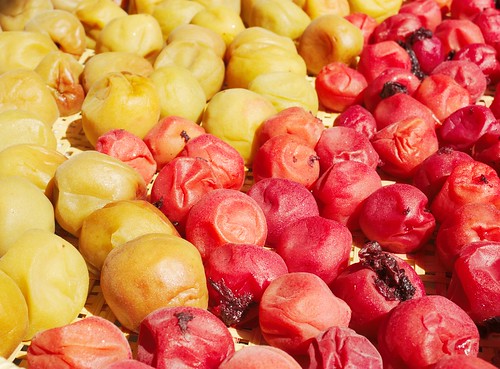
If you make your own umeboshi (pickled plums) then Obon is the perfect time to take them out to dry. They've been pickled in salty brine since June, and now they'll dry out, becoming firm and meaty. You need three days or so of sunny weather, and you need to watch the weather so you can get home and take them inside in case of rainshowers. When dried, they go back into the brine which they'll partially soak up and creating a very juicy, savoury balance of tastes. We are doing two kinds this year; one jar with shiso leaves creating the intense red color and adding some flavour, and one jar without shiso. Both should be good.
I have the entire week off. We are going to Kobe a couple of times - we just recently found another excellent Indian restaurant - and see friends and relatives. This weekend we went out to eat and watch the fireworks with a cousin of Ritsuko's and her husband. Today we're seeing the World Press Photo exhibition that opened in Osaka this week. This travelling exhibition of the best in news photography over the year was very good last year, and I have no doubt it will be fun this year too. The exhibition is held all over the world, basically, so check out the website and if you can, please go.
A week off also means taking the time to do some of those projects and chores that always end up unfinished. I'm trying to get an old camera working, so I'm making a shutter speed meter (very simple, just using a photodiode connected to the computer microphone input), and I'll be trying to get back on an old project of mine doing a small independent rover (where, incidentally, I'll have use for the same speed metering circuit as above). It's been long enough that I may simply need to start over - I don't even have the computer with the original code anymore. Since my project ends this year I'm looking into what I should be doing next, and having a week off is a good time for that; I'll probably post more on this at some point.

If you make your own umeboshi (pickled plums) then Obon is the perfect time to take them out to dry. They've been pickled in salty brine since June, and now they'll dry out, becoming firm and meaty. You need three days or so of sunny weather, and you need to watch the weather so you can get home and take them inside in case of rainshowers. When dried, they go back into the brine which they'll partially soak up and creating a very juicy, savoury balance of tastes. We are doing two kinds this year; one jar with shiso leaves creating the intense red color and adding some flavour, and one jar without shiso. Both should be good.
Thursday, August 7, 2008
Kuhn as Cop-out
Aardvarkeology, a Swedish archaeologist, professional sceptic and blogger (read the blog; it's good) recounts a fragment of a recent debate in his field:
What a great argument! And it works not just in archaeology either:
"The public and media has called my cabinet reshuffle pointless windowdressing. But they all subscribe to an earlier Kuhnian paradigm so their criticism is naturally wildly off the mark."
"No, I didn't do my homework. Homework is part of an earlier Kuhnian paradigm and of course incommensurable with me playing video games all night."
"Yes officer, I'm sure to you it does look like we sold old scraps of pork and chicken as beef. But that's just because you subscribe to an earlier Kuhnian paradigm you see; to me it's actually all prime beef and perfectly legal, I promise."
X: I have discovered that tomatoes were grown in Ireland in the Neolithic.
Y: That is highly unlikely. The seeds and leaf remains that form almost the entire base of your assertions belong to turnips. Just check out these pictures for comparison.
X: Professor Y subscribes to an earlier Kuhnian paradigm than myself. Therefore his work is incommensurable with mine, and he is by definition unable to criticise me. I remain convinced that tomatoes were grown in Ireland in the Neolithic.
What a great argument! And it works not just in archaeology either:
"The public and media has called my cabinet reshuffle pointless windowdressing. But they all subscribe to an earlier Kuhnian paradigm so their criticism is naturally wildly off the mark."
"No, I didn't do my homework. Homework is part of an earlier Kuhnian paradigm and of course incommensurable with me playing video games all night."
"Yes officer, I'm sure to you it does look like we sold old scraps of pork and chicken as beef. But that's just because you subscribe to an earlier Kuhnian paradigm you see; to me it's actually all prime beef and perfectly legal, I promise."
Wednesday, August 6, 2008
Olympics and Poison
The Olympics are upon us, something that can't have escaped anyone alive on this planet, deep sea slugs and cave lichen included.
What probably has escaped you is that dumplings with pesticides have been found in China, as reported by Globaltalk 21. Last winter several people got sick from eating imported frozen dumplings from China, and it turned out the dumplings had been deliberately laced with a banned pesticide; an overview is available here. The investigation quickly turned acrimonious with Japanese and Chinese officials claiming the poisoning could not have occurred in their own country.
So, pesticide-laced dumplings have been found in China, raising the probability that the poison indeed did originate in China rather than being added after the dumplings were imported into Japan. Jun Okumura above sees an attempt to discredit or embarrass China by having this information leaked right before the Olympics. To be sure, there's lots of mutual animosity between the countries; I agree with him that there's plenty of people here that would love to discredit China in any way they can.
I disagree with him that this is the intent of releasing this news. A week ago, or two weeks would have been understandable and effective. But releasing such news - or any news - just hours before the start of the Olympics is pretty much the worst thing you can do; if anything this is the perfect time to bury news, not highlight it. During the next two weeks, much of the world is going to ignore the recession; the two wars in Afghanistan and Iraq; the US presidential campaign; and the cost of oil. Some trivial thing like a few poisoned dumplings are not even going to register with much of the people. If it really is an attempt to embarrass China, it is a singularly incompetent one:
- Hey, there's poison in these dumplings here in China!
- Shhh, Ernesto Ramirez is about to jump 4.55!
- Um, ok, good for him, but we found actual poison in these dumplings and...
What probably has escaped you is that dumplings with pesticides have been found in China, as reported by Globaltalk 21. Last winter several people got sick from eating imported frozen dumplings from China, and it turned out the dumplings had been deliberately laced with a banned pesticide; an overview is available here. The investigation quickly turned acrimonious with Japanese and Chinese officials claiming the poisoning could not have occurred in their own country.
So, pesticide-laced dumplings have been found in China, raising the probability that the poison indeed did originate in China rather than being added after the dumplings were imported into Japan. Jun Okumura above sees an attempt to discredit or embarrass China by having this information leaked right before the Olympics. To be sure, there's lots of mutual animosity between the countries; I agree with him that there's plenty of people here that would love to discredit China in any way they can.
I disagree with him that this is the intent of releasing this news. A week ago, or two weeks would have been understandable and effective. But releasing such news - or any news - just hours before the start of the Olympics is pretty much the worst thing you can do; if anything this is the perfect time to bury news, not highlight it. During the next two weeks, much of the world is going to ignore the recession; the two wars in Afghanistan and Iraq; the US presidential campaign; and the cost of oil. Some trivial thing like a few poisoned dumplings are not even going to register with much of the people. If it really is an attempt to embarrass China, it is a singularly incompetent one:
- Hey, there's poison in these dumplings here in China!
- Shhh, Ernesto Ramirez is about to jump 4.55!
- Um, ok, good for him, but we found actual poison in these dumplings and...
- Elena Vladivostoka just got 9.24 in the Womens Alternative Combination!! Do you understand what this MEANS?!
- Well, no, not really but look, about these dump-- Neither do I!! ISN'T THIS EXCITING?!?!?!
- Hello? Dumplings? Poison?
- GO TEAM!! GO TEAM!!
Voigtländer Bessa
While at my parents, it turned out they had some old, unused cameras lying around. One of them was somewhat special: a Voigtländer Bessa I folding 6x9 format camera from 1950. It had been owned by my mother's brother - my uncle - who died young. When he discarded it in favour of a newer camera it apparently became a toy for my mother to play with. As so often, it ended up stuffed into a drawer, into storage and brought along whenever the household moved.

The Voigtländer Bessa I. The front scale on the lens is the distance; the black scale on the side is the shutter speed.
But amazingly, despite its use as a toy and subsequently stuffed into a drawer for many years, it is still complete and still works beautifully. It is a folding camera; as you can see in the picture the lens is set on a collapsible frame and a soft bellows connects it to the housing. When folded up it's quite compact; smaller than my DSLR, and not much bigger than a serious small-format camera. The film format is 6x9; this is about the largest medium format in common use today. You only get 8 images on one roll of film, so there's a metal screen available that blocks half the frame and lets you use it as a portrait 6x4.5 format camera. This almost doubles the number of frames per roll to 15.
This camera still has both the metal screen and the leather case. The bellows look good and have no light leaks at all. The shutter seems to work just fine, and the other mechanics - the folding mechanism, the film advance, the viewfinder - are all fine as well. Even the camera finish is just about flawless, which really is amazing considering its age and the years as a children's toy. To try it out I got a couple of rolls of tri-x 400 (the only B&W 120-format film available in Borlänge). As an aside, the camera store in Borlänge illustrates nicely why the net is killing some camera stores: they carry one single kind of B&W 120-format film, at a cost almost three times the on-line price, and they kept mentioning that they were the only store in town selling it. Needless to say, if I lived in Borlänge I'd avoid that place and order on-line.
Overall, this camera works just like any other, with just a few more manual steps that later cameras do automatically. You advance the film (using the small red window at the back to know when to stop) and open the front. There is no light meter so you use an external meter or make a guess. Once you've decided on the light level you set the aperture and the shutter speed on the lens at the front and cock the shutter with a small lever. You set the focus distance, compose the image using the viewfinder, and take the picture. The viewfinder is a bit hard to use; the eye relief is quite close so with glasses I can't see the whole image at once, and it's a bit dim and blurry. That might simply be a matter of cleaning it of course.
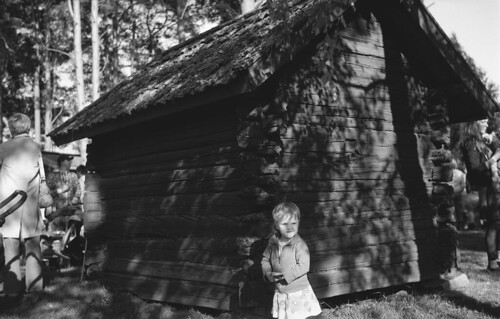
Celebrating midsummer at Torsång. to the far left, way out of focus, is my not-so wayward brother clutching a beer.
How do you focus? You guess. That's right - this camera has no focusing aids whatsoever. There is a focus distance scale on the lens front so you find out the distance to your subject, then set the distance accordingly. You can measure the distance in several ways: a tape measure, for instance, if you are doing a portrait, or mount an external optical rangefinder on the accessory shoe - I'm hunting for one right now by the way; if anyone happens to have one for sale I'd be interested. Or, just take your best guess, then stop down the lens to f/11 or f/16 or so; that way your subject will hopefully still be in focus even if your guess is off.
The results from the camera are perfectly fine. With no way to measure distance I did as I describe above: I guessed the distance and stopped down the lens to compensate. The result is fairly low contrast, with a slightly dreamy look. Not hugely sharp, but then I'd not expect it either from a sixty year old camera made for older lower-resolution films (and our scanner isn't helping matters either). With no reliable way to focus and with a fairly low-resolution lens, this camera is probably best used with a fast film that allows you to stop down. The resulting graininess will only help the perceived sharpness of the images. There's a few more images available in the Flickr set.

The Voigtländer Bessa I. The front scale on the lens is the distance; the black scale on the side is the shutter speed.
But amazingly, despite its use as a toy and subsequently stuffed into a drawer for many years, it is still complete and still works beautifully. It is a folding camera; as you can see in the picture the lens is set on a collapsible frame and a soft bellows connects it to the housing. When folded up it's quite compact; smaller than my DSLR, and not much bigger than a serious small-format camera. The film format is 6x9; this is about the largest medium format in common use today. You only get 8 images on one roll of film, so there's a metal screen available that blocks half the frame and lets you use it as a portrait 6x4.5 format camera. This almost doubles the number of frames per roll to 15.
This camera still has both the metal screen and the leather case. The bellows look good and have no light leaks at all. The shutter seems to work just fine, and the other mechanics - the folding mechanism, the film advance, the viewfinder - are all fine as well. Even the camera finish is just about flawless, which really is amazing considering its age and the years as a children's toy. To try it out I got a couple of rolls of tri-x 400 (the only B&W 120-format film available in Borlänge). As an aside, the camera store in Borlänge illustrates nicely why the net is killing some camera stores: they carry one single kind of B&W 120-format film, at a cost almost three times the on-line price, and they kept mentioning that they were the only store in town selling it. Needless to say, if I lived in Borlänge I'd avoid that place and order on-line.
Overall, this camera works just like any other, with just a few more manual steps that later cameras do automatically. You advance the film (using the small red window at the back to know when to stop) and open the front. There is no light meter so you use an external meter or make a guess. Once you've decided on the light level you set the aperture and the shutter speed on the lens at the front and cock the shutter with a small lever. You set the focus distance, compose the image using the viewfinder, and take the picture. The viewfinder is a bit hard to use; the eye relief is quite close so with glasses I can't see the whole image at once, and it's a bit dim and blurry. That might simply be a matter of cleaning it of course.

Celebrating midsummer at Torsång. to the far left, way out of focus, is my not-so wayward brother clutching a beer.
How do you focus? You guess. That's right - this camera has no focusing aids whatsoever. There is a focus distance scale on the lens front so you find out the distance to your subject, then set the distance accordingly. You can measure the distance in several ways: a tape measure, for instance, if you are doing a portrait, or mount an external optical rangefinder on the accessory shoe - I'm hunting for one right now by the way; if anyone happens to have one for sale I'd be interested. Or, just take your best guess, then stop down the lens to f/11 or f/16 or so; that way your subject will hopefully still be in focus even if your guess is off.
The results from the camera are perfectly fine. With no way to measure distance I did as I describe above: I guessed the distance and stopped down the lens to compensate. The result is fairly low contrast, with a slightly dreamy look. Not hugely sharp, but then I'd not expect it either from a sixty year old camera made for older lower-resolution films (and our scanner isn't helping matters either). With no reliable way to focus and with a fairly low-resolution lens, this camera is probably best used with a fast film that allows you to stop down. The resulting graininess will only help the perceived sharpness of the images. There's a few more images available in the Flickr set.
Monday, August 4, 2008
Stockholm
Stockholm is one of the rare places for me that is better in reality than in my memories. Memories - heavily edited by time and the imperfections of recollection - are often little more than collections of highlights, with a few of the more interesting low points wrapped in a sheen of nostalgia. All the long unmemorable hours in between are neatly excised by virtue of being, well, unmemorable. Reality is inevitably less exciting than your own mind's best-of compilation.
Not so for Stockholm. Every time I return I find the city more enjoyable than I remember. Of course, one reason could be that I lived close to it for a couple of years as a high-school student, and the most enduring memories are all of drudging through slushy streets during dark, wet, miserably chilly winters. By contrast, the last time we visited Stockholm we were greeted with perhaps the best winter weather I have ever seen in the city; and this time we had a warm, bright if somewhat unstable early summer to enjoy.
We stayed just one night in Stockholm, on the way between Helsinki and Borlänge. As with Helsinki, we spent just about all our time walking in the central city. Unlike Helsinki, Stockholm is large enough to really feel like a city rather than a town. If we ever decide to move to Scandinavia, Stockholm would be the place to live.
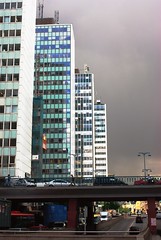 Stockholm has a lot of fairly old architecture around; unlike Helsinki, it was not all designed at the same time to the same extent. The architectural space stretches from the Old Town, with houses frequently five-hundred years old, on foundations older still; gradually through newer areas like Söder and Vasastan where buildings are typically just a century or so; to the rather depressing city center with the "Hötorgsskraporna" high-rises (in the picture to the left) and other fever-dreams realized during the 1960s. Not that much of old Stockholm couldn't do with a good tear-down - the city was by all measures a poor, dirty, disease-ridden squalid mess up until after the second world war or so, despite what some city romantics want to claim - but the particular replacements going up specifically in the 1960's was, unlike earlier eras, not what anybody would regard as aesthetic improvements.
Stockholm has a lot of fairly old architecture around; unlike Helsinki, it was not all designed at the same time to the same extent. The architectural space stretches from the Old Town, with houses frequently five-hundred years old, on foundations older still; gradually through newer areas like Söder and Vasastan where buildings are typically just a century or so; to the rather depressing city center with the "Hötorgsskraporna" high-rises (in the picture to the left) and other fever-dreams realized during the 1960s. Not that much of old Stockholm couldn't do with a good tear-down - the city was by all measures a poor, dirty, disease-ridden squalid mess up until after the second world war or so, despite what some city romantics want to claim - but the particular replacements going up specifically in the 1960's was, unlike earlier eras, not what anybody would regard as aesthetic improvements.
Fortunately, the enthusiasm for tearing down the old was stopped in time; the slums disappeared, butinsane grandiose plans of tearing down much of the Old Town, Söder and some of the most beautiful park areas in the city to make room for a multi-lane highway cutting through the city center were shelved in time.
As it happens, just as we were in Stockholm Swedens most renowned photographer by the name of Lennart Nilsson came out with "Stockholm". He has done major features in Life magazine, Time and many others, and is perhaps most famous for his in-vivo macro images of conception, fetus development and birth for Life magazine, then expanded into a book; he is faculty at Karolinska Institutet in Stockholm today. But in the years around and after the second world war he was a freelancer based in Stockholm and did both several large features as well as hundreds or thousands of daily shots of city life. This is a book collecting his images from around 1948 to 1960 or so; vividly and beautifully documenting life in the city as it transformed itself from a poor backwater into a modern European capital. I can't praise this book enough.

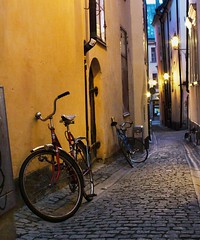
The Old Town was spared destruction in the 1960's and still looks much like it did in the 1600's, give or take open sewers on one hand and a few tens of thousands of tourists on the other of course.
Stockholm itself has not changed much since I last lived in Sweden. One thing that has changed is the sheer number of sushi restaurants - in 1995 or so I'd never seen one; now you couldn't throw a dead cod without hitting a sushiya. And not upscale "real" Japanese-style restaurants either, but mostly small, cheap lunch restaurant-style places offering an eclectic mix of Japanese foods in addition to the ubiquitous nigiri sushi. And many other cheap eateries have tacked onto the new trend and offers sushi dishes along with their normal menu.
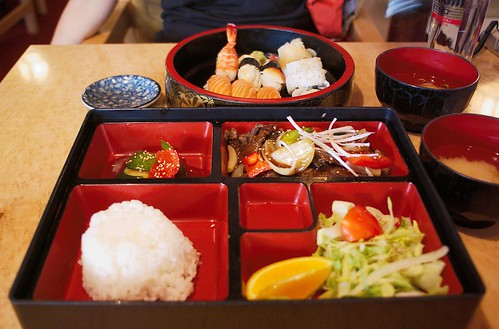
We ate lunch at a small Japanese place the day we arrived. My yakiniku set was good and Ritsukos sushi set was just fine if a bit different. On one hand, squid and octopus was very conspicuous by its absence; on the other, the salmon nigiri (three pieces!) was better than any salmon we've had in Japan.
The future of sushi looks to me much like pizza, Thai food, or Turkish kebab, all of which boomed wildly in popularity for a few years, then settled and became part of the normal national cuisine, changing substantially in the process. Italians, Thai, and Turks would all be very surprised, if not downright dismayed, at what Sweden has done to them and I have great faith in my countrymen's ability to do the same thing with Japanese food. Of course, Japanese should not complain (most countries do not consider Tabasco an essential condiment on pizza); nevertheless there is a drive planned to encourage authentic cuisine abroad by way of a certification scheme. I suspect that scheme will largely fail, and that its failure is a good thing. We get new wonderful flavours and food experiences precisely when traditions clash and creativity is rewarded - as it happens, Tabasco is excellent on pizza.
Stockholm was just a one-night stay this time. Far too short, especially in the summer. With more time we could have gone to Djurgården to walk and check the museums; take a ferry out to some nearby islands; go to Skansen and Gröna Lund; watch people at Hötorget... Next time. As it was, we soon left by train to Borlänge and my family.
Edit: forgot the link to the rest of the Stockholm images.
Not so for Stockholm. Every time I return I find the city more enjoyable than I remember. Of course, one reason could be that I lived close to it for a couple of years as a high-school student, and the most enduring memories are all of drudging through slushy streets during dark, wet, miserably chilly winters. By contrast, the last time we visited Stockholm we were greeted with perhaps the best winter weather I have ever seen in the city; and this time we had a warm, bright if somewhat unstable early summer to enjoy.
We stayed just one night in Stockholm, on the way between Helsinki and Borlänge. As with Helsinki, we spent just about all our time walking in the central city. Unlike Helsinki, Stockholm is large enough to really feel like a city rather than a town. If we ever decide to move to Scandinavia, Stockholm would be the place to live.
 Stockholm has a lot of fairly old architecture around; unlike Helsinki, it was not all designed at the same time to the same extent. The architectural space stretches from the Old Town, with houses frequently five-hundred years old, on foundations older still; gradually through newer areas like Söder and Vasastan where buildings are typically just a century or so; to the rather depressing city center with the "Hötorgsskraporna" high-rises (in the picture to the left) and other fever-dreams realized during the 1960s. Not that much of old Stockholm couldn't do with a good tear-down - the city was by all measures a poor, dirty, disease-ridden squalid mess up until after the second world war or so, despite what some city romantics want to claim - but the particular replacements going up specifically in the 1960's was, unlike earlier eras, not what anybody would regard as aesthetic improvements.
Stockholm has a lot of fairly old architecture around; unlike Helsinki, it was not all designed at the same time to the same extent. The architectural space stretches from the Old Town, with houses frequently five-hundred years old, on foundations older still; gradually through newer areas like Söder and Vasastan where buildings are typically just a century or so; to the rather depressing city center with the "Hötorgsskraporna" high-rises (in the picture to the left) and other fever-dreams realized during the 1960s. Not that much of old Stockholm couldn't do with a good tear-down - the city was by all measures a poor, dirty, disease-ridden squalid mess up until after the second world war or so, despite what some city romantics want to claim - but the particular replacements going up specifically in the 1960's was, unlike earlier eras, not what anybody would regard as aesthetic improvements.Fortunately, the enthusiasm for tearing down the old was stopped in time; the slums disappeared, but
As it happens, just as we were in Stockholm Swedens most renowned photographer by the name of Lennart Nilsson came out with "Stockholm". He has done major features in Life magazine, Time and many others, and is perhaps most famous for his in-vivo macro images of conception, fetus development and birth for Life magazine, then expanded into a book; he is faculty at Karolinska Institutet in Stockholm today. But in the years around and after the second world war he was a freelancer based in Stockholm and did both several large features as well as hundreds or thousands of daily shots of city life. This is a book collecting his images from around 1948 to 1960 or so; vividly and beautifully documenting life in the city as it transformed itself from a poor backwater into a modern European capital. I can't praise this book enough.


The Old Town was spared destruction in the 1960's and still looks much like it did in the 1600's, give or take open sewers on one hand and a few tens of thousands of tourists on the other of course.
Stockholm itself has not changed much since I last lived in Sweden. One thing that has changed is the sheer number of sushi restaurants - in 1995 or so I'd never seen one; now you couldn't throw a dead cod without hitting a sushiya. And not upscale "real" Japanese-style restaurants either, but mostly small, cheap lunch restaurant-style places offering an eclectic mix of Japanese foods in addition to the ubiquitous nigiri sushi. And many other cheap eateries have tacked onto the new trend and offers sushi dishes along with their normal menu.

We ate lunch at a small Japanese place the day we arrived. My yakiniku set was good and Ritsukos sushi set was just fine if a bit different. On one hand, squid and octopus was very conspicuous by its absence; on the other, the salmon nigiri (three pieces!) was better than any salmon we've had in Japan.
The future of sushi looks to me much like pizza, Thai food, or Turkish kebab, all of which boomed wildly in popularity for a few years, then settled and became part of the normal national cuisine, changing substantially in the process. Italians, Thai, and Turks would all be very surprised, if not downright dismayed, at what Sweden has done to them and I have great faith in my countrymen's ability to do the same thing with Japanese food. Of course, Japanese should not complain (most countries do not consider Tabasco an essential condiment on pizza); nevertheless there is a drive planned to encourage authentic cuisine abroad by way of a certification scheme. I suspect that scheme will largely fail, and that its failure is a good thing. We get new wonderful flavours and food experiences precisely when traditions clash and creativity is rewarded - as it happens, Tabasco is excellent on pizza.
Stockholm was just a one-night stay this time. Far too short, especially in the summer. With more time we could have gone to Djurgården to walk and check the museums; take a ferry out to some nearby islands; go to Skansen and Gröna Lund; watch people at Hötorget... Next time. As it was, we soon left by train to Borlänge and my family.
Edit: forgot the link to the rest of the Stockholm images.
Subscribe to:
Comments (Atom)


